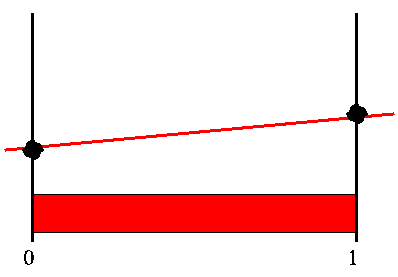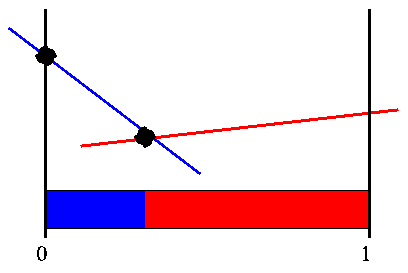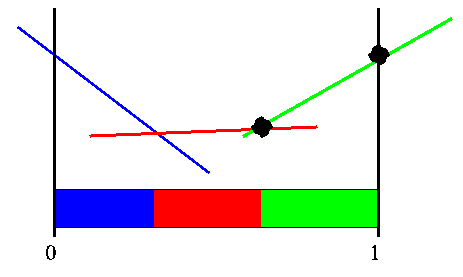The next algorithm, proposed by Cheng (1988), starts with Sondik's idea, but opts for less strict constraints. Cheng's linear support algorithm forgets about focusing on actions and future courses of actions. It simply picks a point, generates the vector for that point and then checks the region of that vectors to see if it is the correct one at all corners (vertices) of the region. If not it adds the vector at that point and checks its region.
This sequence of figures shows how Cheng's linear support region works. It starts with an arbitrary point, and we assume we pick the middle point in the belief space. For a given point we can easily find the best vector at that point, though we have no idea of what the region is where this vector is best. We assume that this vector is V' and attempt to either prove or disprove that this is the real V' we are after. Here is what we start with:

If this is not the true V' then the biggest different between the two must lie at one of the edge points of the belief region where that vector dominates. Since we only have one vector, it dominates everywhere and the edge points are the two extreme points of the belief space. When then go through these points, and generate the vectors at these points. When we plug in the far left point we find that the vector we generate is different from the one we previously found. We throw this vector into our set of vectors and assume that this is V'.

If we check the edge points of the region where the blue vector is better than the red vector, we find either points we have dealt with before or that they generate a vector we already have. We still have the rightmost belief point which we generated from the first vector. When we generate the vector for this point we find a new vector, so we include that in our set.

When we check the corner points of the green vectors region, we find either duplicate points or points that generate duplicate vectors. Since we have check each vectors region and processed all the points, we are assured that the current set of vector is indeed the value function, V' we were looking for.
The two key points are: if the value function is incorrect, the biggest difference will occur at a corner; and if we generate all possible region corners, we are assured of not missing anything.
Continue
 POMDP.org
POMDP.org